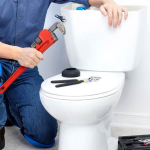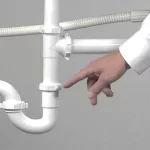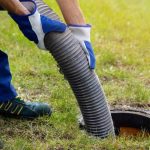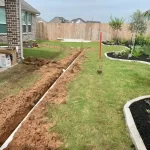A clean and efficient plumbing system is essential for any home or business. One of the most common yet overlooked maintenance tasks is grease trap cleanout. Grease traps prevent fats, oils, and grease from entering the main drainage system, helping to avoid clogs and costly plumbing repairs. Whether you operate a busy restaurant or simply want to maintain your kitchen plumbing, learning how to clean a grease trap properly can save you from major plumbing problems down the road.

Content
What Is a Grease Trap and Why Is It Important?
A grease trap, also called a grease interceptor, is a small tank connected to your sink’s drainage line. Its job is to capture grease and food solids before they flow into the sewer lines. Over time, grease builds up and hardens, which can lead to blockages that require the help of a plumber near me or even sewer repair near me if ignored.
Grease traps are critical for commercial kitchens, cafes, and restaurants that deal with large amounts of cooking oil and waste. Regular maintenance not only prevents plumbing issues but also helps maintain hygiene standards and compliance with local environmental regulations.
How Often Should You Do a Grease Trap Cleanout?
The frequency of grease trap cleanout depends on how much grease your kitchen produces. Most commercial kitchens need cleaning every one to three months, while smaller systems may need it less often. A simple way to know it’s time is if you notice:
- Slow drainage or backups in your sinks
- Foul odors coming from the drain
- Grease visible on top of the water in the trap
If these signs appear, it’s best to schedule professional drain cleaning near me or grease trap cleanout services immediately.
Step-by-Step: How to Perform a Grease Trap Cleanout
1. Prepare Your Tools and Safety Gear
You’ll need gloves, a face mask, a scraper, a bucket, and a shop vacuum. Make sure to protect yourself from strong odors and bacteria that may be present in the trap.
2. Turn Off Water Flow and Remove the Lid
Shut off any running water and carefully remove the lid of the grease trap. Be gentle — the lid may be sealed tightly due to accumulated grease.
3. Measure and Record Grease Levels
Before cleaning, measure the depth of the grease and solids. Keeping a cleaning log helps determine how often your system needs servicing and ensures compliance with local regulations.
4. Scoop Out the Grease
Use your scraper or vacuum to remove grease and solid waste. Be sure to clean all the walls and baffles inside the trap. Leftover residue can quickly cause new buildup.
5. Wash and Rinse
After removing all waste, use warm water mixed with a mild detergent to wash the interior surfaces. Avoid using harsh chemicals, as they can damage your plumbing and harm the environment.
6. Reassemble and Test the System
Once clean, reattach the lid and flush the system with hot water to ensure proper drainage. If you still notice slow draining, it might be time to call a plumber near me for a deeper drain cleaning near me service.
When to Call a Professional Plumber
While small grease traps can be cleaned manually, larger or more complex systems often require professional attention. Expert plumbers have specialized equipment to pump out and dispose of grease safely. They can also inspect the plumbing lines for blockages that may lead to sewer repair near me needs if not addressed early.
Hiring a professional ensures:
- Complete grease removal
- Compliance with local disposal regulations
- Fewer plumbing emergencies
- Longer lifespan of your drainage system
A quick search for a plumber near me who specializes in grease trap cleanout can save you time, money, and stress.
The Connection Between Grease Traps and Other Plumbing Services
Many property owners don’t realize how connected their plumbing systems are. If a grease trap is neglected, the resulting blockages can affect other systems, including:
- Sewer lines, which may require sewer repair
- Septic systems, which could eventually need septic tank services
- Drains, which often need drain cleaning to restore flow
Maintaining your grease trap regularly helps prevent these problems and ensures all parts of your plumbing system work efficiently together.
Why Regular Maintenance Matters
Ignoring grease trap maintenance can lead to:
- Costly plumbing repairs
- Foul odors in your kitchen or restaurant
- Health code violations
- Environmental contamination
Routine grease trap cleanout keeps your drains flowing smoothly, reduces emergency plumbing costs, and helps protect your property and community from pollution.
Environmental and Financial Benefits
Proper grease disposal is not just good for your pipes—it’s also good for the environment. When grease enters public sewers, it can combine with other waste to create massive clogs known as “fatbergs.” These blockages are expensive to remove and can cause sewage overflows. By scheduling regular grease trap cleanout, you’re contributing to cleaner water systems and avoiding future repair bills.
Final Thoughts
A well-maintained grease trap is the foundation of a healthy plumbing system. Whether you run a commercial kitchen or maintain a household, regular grease trap cleanout keeps your drains clear and your environment sanitary. Don’t wait for a clog or backup to call a plumber near me — proactive maintenance can save you from bigger headaches later.
If you notice slow drainage, gurgling sounds, or foul odors, reach out to a trusted plumbing professional for expert septic tank services near me. With consistent care, your plumbing will stay efficient, odor-free, and environmentally friendly.

My name is Gwen Elmore. I post about home improvement ideas and how to make your home look beautiful and liveable. I hope my posts will help you with your DIY projects!









